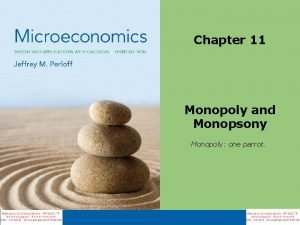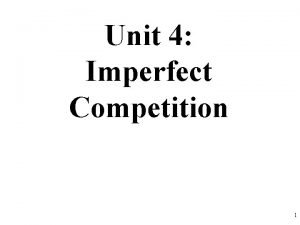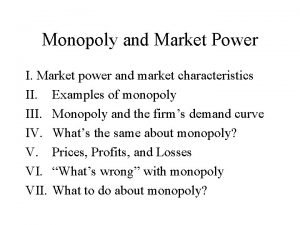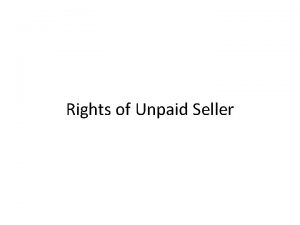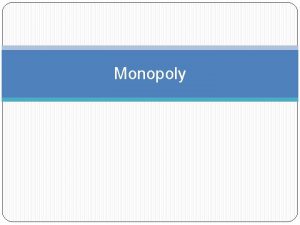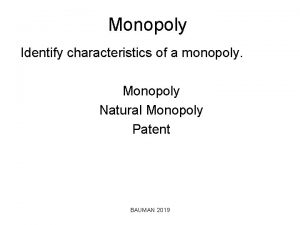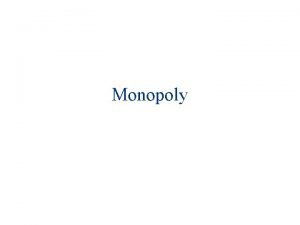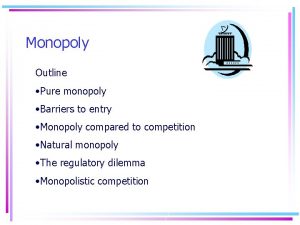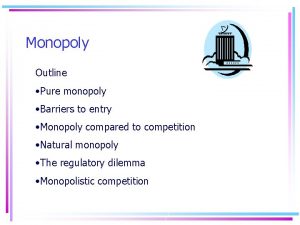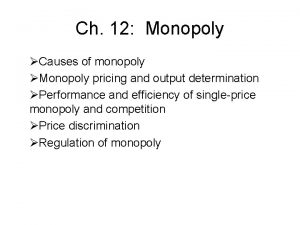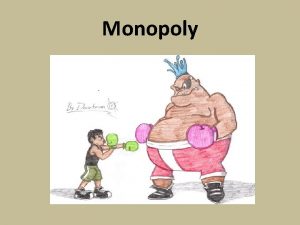MONOPOLY CHARACTERISTICS One seller of a good or

















- Slides: 17

MONOPOLY

CHARACTERISTICS ØOne seller of a good or service ØCompletely differentiated good ØNo close substitutes for the good ØBarriers to entry Ø Legal barriers (patents, licenses) Ø Economies of scale Ø Control over resources ØAll are characteristics of an unregulated monopoly

MONOPOLY DEMAND 1. Firm and market are the same 2. Downward sloping demand curve 3. In order to sell MORE a monopolist must lower prices 4. MR is also downward sloping as a result 5. MR will be located below demand 6. Monopolist can charge more than a PC firm but MUST follow the Law of Demand 7. Monopolist always operates in the ELASTIC portion of the demand curve

MC PM D QM MR

KEY GRAPH POINTS • Always produce where MC = MR • Profit maximizing!!!!! • Price is set based on demand curve NOT MC or MR • Unregulated monopolies can earn positive economic profits if P>ATC

Profit Earning MC ATC PM D QM MR

EFFICIENCY • Is a monopoly efficient? • NO! NO! • Monopolies violate both types of efficiency • Allocative efficiency: market produces a level of output where MC=MB (MC=D) • Productive efficiency: firms produce at lowest possible cost (P=ATC minimum) • Hint: Perfectly competitive firms are always efficient!

MC ATC PM Produce here for productive efficiency Produce here for allocative efficiency D QM MR

MC ATC PM Monopolies create deadweight loss DWL D QM MR

MONOPOLY TRICKS

PRICE DISCRIMINATION • Selling the same good at different prices to different people • To exist: • Must have monopoly power • Must be able to sort consumers into groups • Must be able to prevent RESALE between consumers • Examples: • • Age discounts at theatres Coupons Early order discounts Buying bulk gets cheaper unit price

• To prevent resale: • Immediate consumption of item • Tied to identity (airlines)

NATURAL MONOPOLIES

NATURAL MONOPOLY • Unique situation where 1 single firm is more efficient than having competition • Exists because of economies of scale • Costs to produce are so high that firms could never earn back if had to compete

REGULATED MONOPOLIES

REGULATION • Two types of regulation on monopolies: • Both intended to make firms more efficient and benefit consumers • Socially optimal: forces monopoly to act like a perfectly competitive firm • Must produce where P=MC • Creates allocative efficiency • Can create losses for monopoly • Fair return: • P=ATC • Courts state firms can not be forced to operate at losses

P Unregulated monopoly ATC PM PSO MC Fair Return Socially Optimal D QM MR Q
 A market dominated by a single seller
A market dominated by a single seller Good words good thoughts good deeds
Good words good thoughts good deeds Hi good afternoon how are you
Hi good afternoon how are you Hello teacher good afternoon
Hello teacher good afternoon You are good you are good when there's nothing good in me
You are good you are good when there's nothing good in me Cómo se dice buenas tardes
Cómo se dice buenas tardes Monopoly one
Monopoly one One major barrier to entry under pure monopoly arises from
One major barrier to entry under pure monopoly arises from Lump sum subsidy
Lump sum subsidy Monopoly characteristics
Monopoly characteristics Characteristic of monopoly
Characteristic of monopoly Disadvantages of monopoly
Disadvantages of monopoly Characteristics of monopoly market
Characteristics of monopoly market One empire one god one emperor
One empire one god one emperor One one little dog run
One one little dog run One king one law one faith
One king one law one faith One empire one god one emperor
One empire one god one emperor One team one plan one goal
One team one plan one goal






